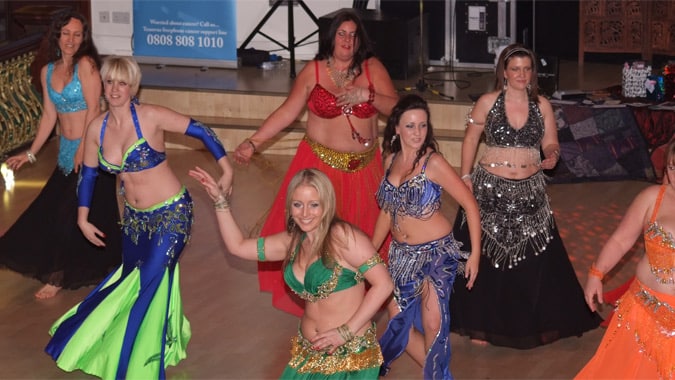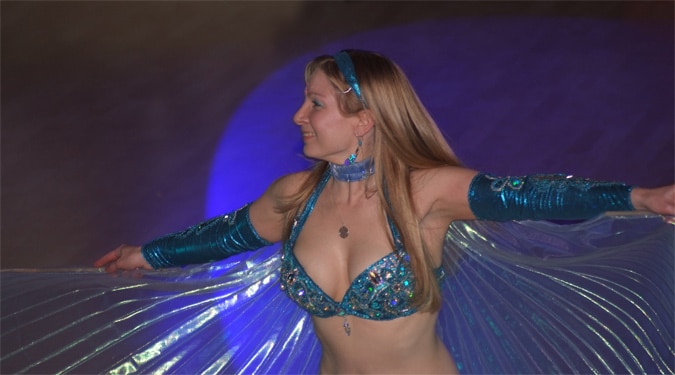10 Myths about Belly Dance
Last Updated on February 4, 2024
Belly dance, Raqs Sharki, oriental dance, Arabic dance, Middle Eastern dance, or whatever you prefer to call it, has always been a victim of several misconceptions.
In order to explain some very common misconceptions and often misunderstood ideas on this form of dance, 10 of the biggest myths are explained below.
1. Belly dance is for Big People
One of the absolute core attractions of belly dance is that it actually attracts and suits every woman’s shape, hence it is common to see big women belly dancing, but also slim and all shaped and sized women (and even some men).
You do not need to be big to emphasize the movements of your body if your technique is correct i.e. you can be very slim and be a great belly dancer.
What is true though is that belly dance promotes a more inclusive idea of body sizes than other forms of dance, such as ballet.
Especially amongst the most experienced dancers, body shape and size is not considered particularly important.
There is a wide acceptance of the way people naturally look.
There is an interesting article, published in the Journal of Gender Studies, called ‘Body Image in Belly Dance: integrating alternative norms into collective identity’, in which the authors investigate body image perceptions among women belly dancers in America.
They found that belly dance does indeed promote a very inclusive body image.
They say that there are two main body images that are attached to belly dancing: that of the harem woman and that of a woman who can be of any shape or size and is happy in her own skin.
The harem woman fantasy is the one that we find in many Hollywood movies, of a sensual femme fatale and this is mainly encouraged when belly dancing is performed for the general public, in places such as restaurants.
The other inclusive image is encouraged within belly dancing circles and, the longer dancers have been involved in this activity and been part of the belly dance community, the more they accept this image.

2. The Origins of Belly Dance
This dance form originated in harems and was performed by women to entertain men.
This is largely fantasy and is one that was created by male Western travelers to the Middle East in the late 1800s and perpetuated and enhanced by the Hollywood film industry.
Quite the opposite is true in fact, given that in traditional societies where women and men were segregated, this type of dance was and still is performed amongst women when they get together.
Outside of its countries of origin, belly dancing is still a type of dance which is mainly danced by women for women (although there are male belly dancers too) and the men who attend belly dancing shows as part of the audience in western countries are usually dragged along by their female partners, friends and relatives!
3. Belly Dance is Like Stripping or Adult Entertainment
This idea is another distinct misconception created in Western societies between the late 1800s and early 1900s.
This association can be due to the fact that Europeans and Americans did not understand the movement vocabulary of this dance form.
In particular, moving the torso was considered immoral, in a society where women had to wear corsets.
Not to mention the misconceptions that Westerners had of Middle Eastern societies, which they wrongly perceived as being more sensual and less rational that the west, which fed orientalist fantasies of dissolute harems.
In particular, the association between vaudeville dance and belly dance started in America in 1893 at the World’s Columbian Exposition in Chicago, USA, where a dancer nicknamed Little Egypt performed.
Some people loved her dance, others were shocked and vaudeville dancers started imitating some of her hips movements. Read more about the associations between belly dance and burlesque.
4. Only Women Can Belly Dance.
here are in fact several male belly dancers, who are very good. Also in the past, in traditional cultures, men routinely performed this type of dance.
You can, in fact, learn about some of the best male dancers on our dedicated page to the best male performers.
In its countries of origin men still dance socially using movements that are reminiscent of belly dancing, such as fluid arm movements and hip movements.
These movements look feminine to Western audiences because they do not fit with our idea of masculinity, but gender stereotypes are in reality culturally constructed.
Nowadays in countries such as Egypt, men perform folkloric dances, rather than Raqs sharqi, while in Western countries some men perform both folkloric and Raqs sharqi styles, but they are still a small minority.

5. Belly Dance Costumes are Skimpy
Some costumes can be but many costumes also cover a large part or all of the body. It really comes down to preference and the type of outfit and costume you prefer.
Consider also that the costumes are certainly no more revealing than most other forms of dance.
There are a lot of outfits that cover the body much more than a ballet leotard does, an example the beledi dresses or tribal costumes with long and layered skirts.
In fact, even some cabaret belly dancers especially in Egypt, wear a thin transparent net to cover their torso when wearing a two-piece costume.
The bedlah, or two-piece cabaret costume, is, in reality, a Hollywood invention that Egyptians and Turkish dancers afterward copied and now in Egypt and Turkey, they make beautiful and elaborated bedlah, selling them to dancers all over the world.
6. Belly Dancing is Easy
Just because belly dancing does not force the body into unnatural positions, it does not mean it does not require a lot of training, patience, and dedication to achieve those seemingly effortless moves.
There are many different levels that you can reach and there is certainly a distinct difference between beginners, intermediate, advanced, and professional-level dancers.
There are more different specific parts of the body to isolate in this dance form, than any other type of dance.
7. This Type of Dance is Boring
Building on from the previous point, not only are there so many ways in which to isolate movements with different parts of the body, but there are also a lot of different dance styles.
From tribal to cabaret, Egyptian, Turkish, and more. Although they all share the same basic vocabulary, they are all different. This type of dance may not be for everyone, but there is plenty to learn and experience.
8. You Have to Wear a Belly Ring
Some do, but this is not a must for belly dancers nor it is the traditional look, but rather a fashion invented by Hollywood, just like the typical two pieces cabaret costume with bra and veil skirt nowadays adopted by most cabaret-style belly dancers.

9. Dancers in the Middle East Dance Balancing a Sword on Their Heads
In reality, there is no evidence of dancing with swords in the Middle East, while this is an art invented by the Americans.
However, the art of shamadan, or balancing a candelabrum on the head, seems to originate in Egypt where it was done by a professional dancer at weddings.
Veil work was also invented by the Americans, especially elaborated veil work such as double veils.
In Egyptian Raqs sharqi, the veil is used briefly to make an entrance and then discarded.
10. Belly Dancing is all the Same
As pointed out above in point 7, there are many different styles of belly dance.
It seems, in fact, that belly dancing is an umbrella term to incorporate many different dance genres that share some of their movement vocabularies but which are very different in terms of music used, feelings, costumes, specific movements, technique, and more.
References
- Downey, D., J. Reel, S. SooHoo and S. Zerbib (2010). “Body image in belly dance: integrating alternative norms into collective identity.” Journal of Gender Studies 19(4): 377-393.
- Intangible Cultural Heritage Beyond Borders: Egyptian Bellydance (Raqs Sharqi) as a Form of Transcultural Heritage – V Loiacono, J Fallon. Journal of Intercultural Studies 39 (3), 286-304.
Latest posts by Dr Valeria Lo Iacono (see all)
- Belly Dancing over the Age of 40, 50 and Beyond - February 1, 2025
- Health Benefits of Belly Dance - January 20, 2024
- 10 Countries for Learning Belly Dance - January 18, 2024
Related Posts
One thought on “10 Myths about Belly Dance”
Comments are closed.


















It is also done in Central Asia and Mongolia. Not sure when it was brought from the Middle East